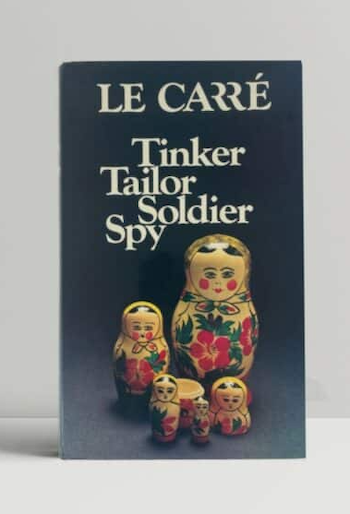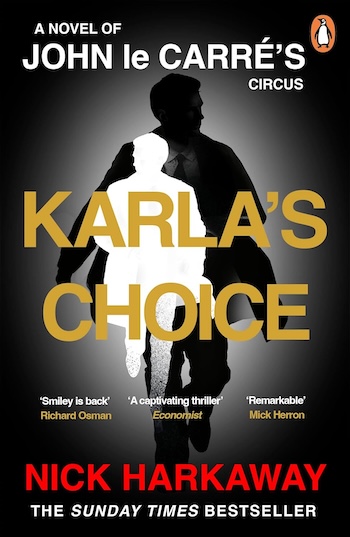Following in the footsteps of the master of any trade, let alone when that master is your own father, can be a dangerous journey. It becomes an even greater challenge if it involves attempting to recreate the characters and atmosphere of an imaginary world that has engaged and entranced millions. This is what Nick Harkaway has done with his most recent book Karla’s Choice.
He was already following in the footsteps of his father, John Le Carré, as a successful professional writer. But with Karla’s Choice Harkaway has chosen to enter his father’s most personal territory. He has not only set out to recreate the hauntingly atmospheric Cold War world of espionage, deception, treachery and paranoia drawn by his father but also to reintroduce his father’s most famous and deeply-drawn character – the clever, somewhat owlish, acute observer of humanity that is George Smiley. Harkaway has most certainly risen successfully to the demanding challenge he has set himself and even the most pedantic and dedicated Le Carré fan should enjoy the ride.
 Harkaway has made a clever chronological choice for the setting of his addition to the Smiley canon. A long gap exists between Smiley’s first three appearances in Call for the Dead, A Murder of Quality and The Spy Who Came in from the Cold running in quick succession in the early 60s, and his reappearance a decade later in the superb Tinker Tailor Soldier Spy – the first of what became the Karla Trilogy.
Harkaway has made a clever chronological choice for the setting of his addition to the Smiley canon. A long gap exists between Smiley’s first three appearances in Call for the Dead, A Murder of Quality and The Spy Who Came in from the Cold running in quick succession in the early 60s, and his reappearance a decade later in the superb Tinker Tailor Soldier Spy – the first of what became the Karla Trilogy.
Harkaway has set Karla’s Choice in 1963 not long after the events in The Spy Who Came in from the Cold which ended with an MI6 agent, a close colleague of Smiley, getting shot in Berlin. As his title indicates Harkaway introduces Karla, the ruthless and devious Soviet spy master who is Smiley’s adversary in his father’s 1970s trilogy. In keeping with the Karla of the trilogy Harkaway not only provides him with a suitably Le Carré-esque back story but also has him start to become the very dangerous shadowy hidden figure that haunts Smiley. As for the choice of the title and its significance I will leave that for those who choose to read the book.
Those who are already Smiley enthusiasts will be pleased to encounter a Circus – Le Carré’s sobriquet for MI6 – full of characters and jargon they will recognise. First-timers will be introduced to a group of people whose backgrounds and approach to life reflect a world long gone. For Le Carré the Circus and its people was often how he represented the patchwork remains of an empire in terminal decline as well as the quirkiness and eccentricity he had experienced during his time in MI6. Harkaway has recreated them well, whether it is Smiley himself, or others such as Oliver Mendel the tough Special Branch officer seconded to the Circus, Connie Sachs the fearfully intelligent mother hen of the Research Section, Jim Prideaux the archetypal field agent or Bill Haydon the arch career smoothie.
As for the jargon, readers will come across references to scalp-hunters (field agents doing the heavy lifting), lamplighters (surveillance teams), the chorus line (semi-official agents called on when their particular skills where needed), bad aunts (part-time female members of the research team with specialist knowledge) and playing by Moscow rules (using all possible safety precautions in especially sensitive and risky operations). It all helps in the recreation of the shadowy world of Cold War espionage that Le Carré created and which provided the background to novels that were so much more than just spy stories.

Kurfürstendamm, Berlin, at night (1963). Photo by Roger Wollstadt (WikiCommons)
Harkaway’s story begins with the sudden and unexplained disappearance of Laszlo Banati, an apparently respectable Hungarian refugee who runs a small but reasonably successful publishing house and the equally unexpected request for asylum by the KGB heavy sent to kill the apparently respectable Hungarian publisher. Smiley, on the verge of retirement from the Circus and about to join his wife on a cultural trip to Geneva, finds himself persuaded to take on the task of unravelling the Hungarian’s inevitably complicated back story, the full reasons for his sudden disappearance, why he was being targeted for assassination, and also for tracking him down. Playing an increasingly important role in the events that follow is Banati’s secretary, Susanna Gero, another Hungarian refugee.
 The hunt begins in London with the Research Section at the Circus pulling together all the background information it can find. It soon spreads to Paris, Zurich and Berlin where the plot thickens still further. The tempo accelerates with a cross-border visit to Budapest that does not go quite as planned and results in an escape back to the West via a drive through Czechoslovakia. All I will say is that it involves events in Portugal which explain the ruthless motive and actions that lie behind Karla’s choice.
The hunt begins in London with the Research Section at the Circus pulling together all the background information it can find. It soon spreads to Paris, Zurich and Berlin where the plot thickens still further. The tempo accelerates with a cross-border visit to Budapest that does not go quite as planned and results in an escape back to the West via a drive through Czechoslovakia. All I will say is that it involves events in Portugal which explain the ruthless motive and actions that lie behind Karla’s choice.
As with his father’s books, the hunt is always more complicated than at first appears. This is never complication for the sake of it but a reflection of reality as departmental rivalries and incomplete or just misinterpreted information influence behaviour and decision-making. Equally important are the impact of the personal beliefs, fears and ambitions on the actions of individual actors. It is hardly surprising that errors of judgement and changes of mind occur, some of which are game-changing and, on occasion, lead to disaster.
Karla’s Choice is a worthy addition to the Smiley canon. It reads well just as a stand-alone story for those who might just want to put a toe in the water before deciding whether to engage with more of Smiley’s career. That said, there is also still chronological space available for Harkaway to fill with another chapter in the history of Smiley’s membership of the Circus. Let us hope that he will take up the challenge and repeat the success of Karla’s Choice.
Karla’s Choice by Nick Harkaway is out now in all formats, published by Viking. For more information, please visit www.penguin.co.uk.




